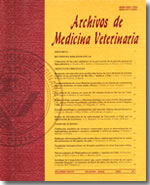Comparison of two different methods for evaluating boar semen morphology
Main Article Content
Abstract
The objective of this study was to compare the use and effectiveness of two different techniques for assessing sperm morphology, the conventional wet preparation with a of formaldehyde-citrate solution 2.94% and the smear using Bengal Rose dye. 58 ejaculates from eight high performance boars aged between 8 and 25 months were evaluated. The sperm morphology was evaluated after collection of each ejaculate using two techniques: conventional wet preparation (formol citrate solution 2.94%) observed in phase contrast microscopy (1.000X magnification) and a smear prepared with Bengal Rose dye, examined under an optical microscope (400X magnification). It was observed that the percentage of alterations of head, acrosome, middle piece and total morphological changes did not differ (P > 0.05) between the two methods. A higher number of tail defects (P < 0.05) was obtained by using the smear technique with Bengal Rose dye when compared to the conventional technique, this was probably due to the preparation technique of the smear that could result in a greater chance of tail breaking, leading to the visualization of this anomaly. It is concluded that the use of the Bengal Rose dye is an efficient method for evaluating the sperm morphology of boar semen, and thats pecial care should be taken when preparing the smear to avoid affecting the results, mainly regarding tail alterations.

